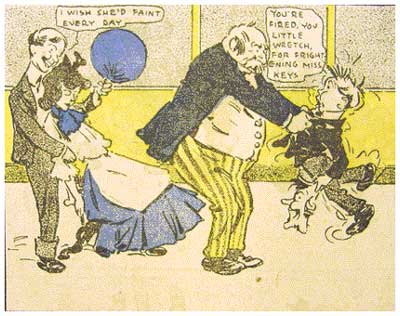Untitled and undated comic strip.
Syd B. Griffin was a late 19th-century and early 20th-century American cartoonist, who published several one-shot pantomime comics and text comics in magazines like Judge and Puck. He had a few short-lived newspaper comic series in the New York World as well. The most durable of these was 'Clarence the Cop' (1901-1908), of which he drew the first few episodes, before it was continued by other artists.
Early life and career
Sydney B. Griffin was born in 1854 in Roxbury, Massachusetts. He was the son of a cabinetmaker of English descent. Griffin's mother was Canadian. The family moved to Detroit, Michigan when he was a young boy. In 1888, Griffin moved to New York, where he applied for a job at Puck - who rejected him - and Judge - who did hire him. At Judge he wrote various poems and drew cartoons. The cartoonist actually went back to Puck to inform them of his successful career at Judge and received an unexpected reply. Apparently Puck didn't reject him because his work was so bad, but more because it was so excellent that they had a suspicion that he had simply plagiarized it. This time they hired him after all. Apart from Judge, Griffin's cartoons also appeared in Truth Magazine. By the mid 1890s, the successful cartoonist moved to Mamaroneck, New York. He was president and director of the New York School of Caricature, founded in 1901. Together with Walt McDougall he also operated a poster company in the late 1890s.
'An Accidental Effect' (Puck, 1891).
Puck
Many of Griffin's cartoons from this period are pantomime or text comics. 'The Accidental Effect' (1891) - published in Puck - features a young girl falling inside a landscape painting, much to the furor of the painter who just finished it. The entire surreal joke is told without dialogue. The idea of people falling into paintings or being fooled into thinking something painted is real would be used by later cartoonists too, such as Ed Payne's 'Billy Boy the Boy Artist' (1899-1955), Hans Horina's 'Mr. Foxy the Artist' (1906-1907) and various animated cartoons from the 1940s on by Tex Avery, Chuck Jones and Hanna-Barbera. Griffin's 'The Boarding House Problem' (1891) features a man renting a room only to have almost all of his furniture taken away by a landlady "to help more needy people." The entire narrative - originally published in Puck - is told with narration underneath each image.
'Four Comical Coons' (12 August 1900).
Four Comical Coons
By 1900, Griffin also began contributing to the Sunday color sections of the New York World, which were often also distributed to the other Joseph Pulitzer papers. Between 12 August and 9 December 1900, he drew a nowadays very racially offensive comic strip titled 'Four Comical Coons' (1900), which was heavily influenced by Rudolph Dirks' 'Katzenjammer Kids' in the sense that it revolved around four children conducting mischief and getting into trouble for it. As the title implies, most of the comedy revolved around stereotypical depictions of African-American people, complete with the black children being pickaninnies parented by a "mammy". Most punchlines involved jokes about love for watermelons, dancing, stealing chickens and talking in jive.
Little Umjiji
On 4 November 1900, Ferd Long created 'Little Umjiji', a pantomime comic about a little black African toddler, but abandoned it after only one episode. Griffin continued the feature between 24 February and 19 May 1901. Compared with 'Four Comical Coons', the comedy in 'Little Umjiji' was more gentle and didn't focus on ethnic stereotypes, more on a little boy interacting with jungle animals.
Other comics
Among Griffin's other Sunday comics for the World were 'Mr. Go-Easy' (1900), 'Aunt Chloe' (7 October - 4 November 1900) and 'The Love Affairs Of The Office Boy' (31 May-16 August 1903). Griffin was also responsible for the first two installments of 'Clarence the Cop', published on 7 and 14 July 1901. The feature was then continued by Charles W. Kahles as a Sunday and weekday comic until 1908.
'The Office Boy' (1903).
Mister Bings and the Twentieth Century
Between 1901 and 1902, Griffin made several text comics for the McClure Syndicate about the bald-headed inventor Reginald Bings, whose inventions always go disastrously wrong, from a hair tonic to a "flying machine". Funny enough, a gag about Bings' flying machine was published on 5 January 1902, almost a year before the Brothers Wright would invent the first successful airplane. Appearing under the title 'Mister Bings and the Twentieth Century ...' (completed with the name of the invention), the Sunday feature was syndicated to newspapers like the St. Louis Republic between 21 July 1901 and 5 January 1902.
Final years and death
By the 1910s, Griffin had moved to Manhattan working as a general illustrator. Syd B. Griffin passed away in 1923 after a long illness.
'Mr. Bings and the Twentieth Century Hair Tonic' (1 September 1901).








